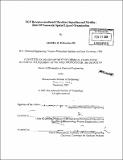| dc.contributor.advisor | Linda G. Griffith. | en_US |
| dc.contributor.author | Richardson, Llewellyn B. (Llewellyn Bentley) | en_US |
| dc.contributor.other | Massachusetts Institute of Technology. Dept. of Chemical Engineering. | en_US |
| dc.date.accessioned | 2008-02-28T16:19:54Z | |
| dc.date.available | 2008-02-28T16:19:54Z | |
| dc.date.copyright | 2005 | en_US |
| dc.date.issued | 2006 | en_US |
| dc.identifier.uri | http://dspace.mit.edu/handle/1721.1/34161 | en_US |
| dc.identifier.uri | http://hdl.handle.net/1721.1/34161 | |
| dc.description | Thesis (Ph. D.)--Massachusetts Institute of Technology, Dept. of Chemical Engineering, February 2006. | en_US |
| dc.description | Includes bibliographical references. | en_US |
| dc.description.abstract | Cell motility is often governed by growth factor receptor and integrin adhesion receptor interactions with the extracellular environment followed by collaborative intracellular signaling. While integrin ligands are necessarily bound within the extracellular matrix to permit force transduction by the cell, the canonical view of growth factors is of soluble molecules freely diffusible and internalizable by the cell. Recent evidence suggests that in some cases growth factor receptor ligands may be embedded in the extracellular matrix and may signal primarily from the cell surface. By altering the trafficking of receptor and ligand, the potential exists to change the spatiotemporal distribution of signaling within the cell. These changes in the magnitude, duration, and spatial localization of specific signals influence the biophysical regulation of cell migration, which is a multi-step process directed by a number of timely and spatially coordinated signaling events. In this work, we develop a polymer incorporating both growth factors and adhesion molecules with nanoscale spatial ligand control to model matrix-embedded ligand presentation. | en_US |
| dc.description.abstract | (cont.) The polymer is a poly(methyl methacrylate)-poly(ethylene oxide) (PMMA-g-PEO) comb copolymer that displays the ligands via 2-3 nm molecular tethers. Two forms of the polymer are employed, one in which epidermal growth factor (EGF) is tethered amidst an adhesive background of adsorbed fibronectin (FN) and a second in which EGF and a FN-like PHSRN-RGD peptide (SynKRGD) are simultaneously tethered. The surface densities of each ligand are independently controlled during their incorporation into the polymer. Thus, variation in substrate adhesiveness is achieved by adsorbing different densities of FN or by covalently tethering different densities of SynKRGD. With these substrates, we use a model cell line of NR6 fibroblasts expressing the wild-type human EGF receptor (EGFR) to observe the effects of surface-tethered EGF on signaling, adhesion, and migration compared to the traditional soluble EGF presentation. Using the EGF-FN substrates, we determine that tethered EGF signals EGFR primarily at the cell-substrate interface. Tethered EGF, like soluble EGF, elicits enhanced migration speed with a biphasic dependence on FN density. However, the peak cell speed for tethered EGF is achieved at an order of magnitude greater FN density. Quantification of cell spread area suggests that tethered EGF reduces cell-substrate adhesion strength relative to soluble EGF. | en_US |
| dc.description.abstract | (cont.) Although we are unable to conclusively attribute the biphasic curve shift on EGF-FN substrates to a specific signaling mechanism, we do observe a dependence of focal adhesion kinase (FAK) signal strength on substrate adhesiveness. Further investigation of EGFR phosphorylations and downstream motility-relevant signals using the EGF-SynKRGD substrates reveals characteristics of tethered EGF signal transduction that are quantitatively distinct from soluble EGF and concomitantly influenced by integrin-mediated adhesion. These results underscore the complex synergy between EGFR and integrins while demonstrating the significance of spatial ligand presentation in regulating cell behavior. | en_US |
| dc.description.statementofresponsibility | by Llewellyn B. Richardson, III. | en_US |
| dc.format.extent | 139 leaves | en_US |
| dc.language.iso | eng | en_US |
| dc.publisher | Massachusetts Institute of Technology | en_US |
| dc.rights | M.I.T. theses are protected by copyright. They may be viewed from this source for any purpose, but reproduction or distribution in any format is prohibited without written permission. See provided URL for inquiries about permission. | en_US |
| dc.rights.uri | http://dspace.mit.edu/handle/1721.1/34161 | en_US |
| dc.rights.uri | http://dspace.mit.edu/handle/1721.1/7582 | |
| dc.subject | Chemical Engineering. | en_US |
| dc.title | EGF receptor-mediated fibroblast signaling and motility : role of nanoscale spatial ligand organization | en_US |
| dc.title.alternative | Epidermal growth factor receptor-mediated fibroblast signaling and motility | en_US |
| dc.type | Thesis | en_US |
| dc.description.degree | Ph.D. | en_US |
| dc.contributor.department | Massachusetts Institute of Technology. Department of Chemical Engineering | |
| dc.identifier.oclc | 69019553 | en_US |
